SEASON 3, LEGENDS: THE SERIES - WATCH THE ENTIRE SEASON
EPISODE 1 - THE LEGEND OF "JUNGLE" PAM HARDY
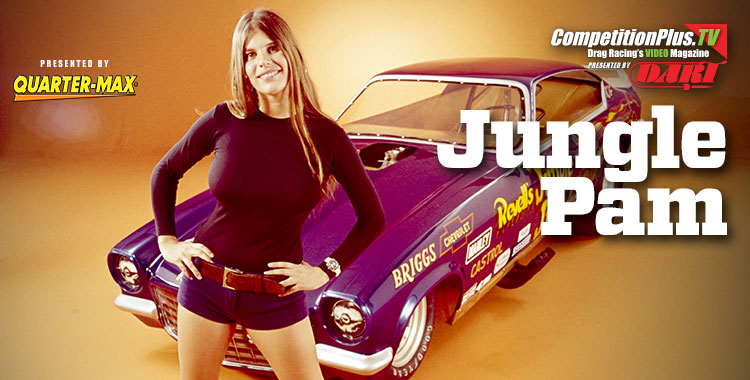 Think about this.
Think about this.
Pamela Hardy, more commonly as Jungle Pam, was in drag racing for only four short years, yet her name remains iconic nearly four decades later. That's major longevity for someone whose main claim to fame was backing up a race car while scantily clad.
Jungle Pam ran the roads as the yin to Jungle Jim Liberman's yang. She was the salt to his pepper. We think you get the drift.
As much as she's enjoyed life as an ordinary citizen of West Chester, Pa., for the last four decades or so, drag racing fans have clamored for drag racing's ultimate backup girl. The day she stepped in front of Liberman, scantily clad, she was sentenced to a life of anything but ordinary.
In this premiere episode of Legends: The Series, Season Three, Jungle Pam discusses those days of barnstorming drag racing and life on the road. She touches on drag racing as she sees it, and the loss of Jungle Jim, a loss she still feels pain for all these years later.
EPISODE 2 - THE LEGEND OF THE BLUE MAX CREW
 It’s hard to imagine that any race car had a bigger international fan base in the 1970s and early ‘80s than did the legendary Blue Max, a Funny Car that captured the imagination of an entire generation of adrenaline junkies.
It’s hard to imagine that any race car had a bigger international fan base in the 1970s and early ‘80s than did the legendary Blue Max, a Funny Car that captured the imagination of an entire generation of adrenaline junkies.
When the late Harry Schmidt had a replica of a German military medal for valor emblazoned on the side of his race car, he could not have imagined what would ensue. Although the ‘Max’ was exceedingly popular from the day it first rolled to the starting line at the 1970 Winternationals, it didn’t really hit its stride until Raymond Beadle came on board in 1975, first as partner with Schmidt and later as sole owner and driver.
In this episode of Legends: The Series, Season Three, “Waterbed Fred” Miller, D. Gantt and Dale Emery, the mechanical trio whose talents sent Beadle to three NHRA and three IHRA world championships as well as countless match victories in the U.S., Canada and England, talk about their amazing run, their Hall of Fame driver and the unique team chemistry that made all of their success possible.
EPISODE 3 - THE LEGEND OF AUSTIN COIL
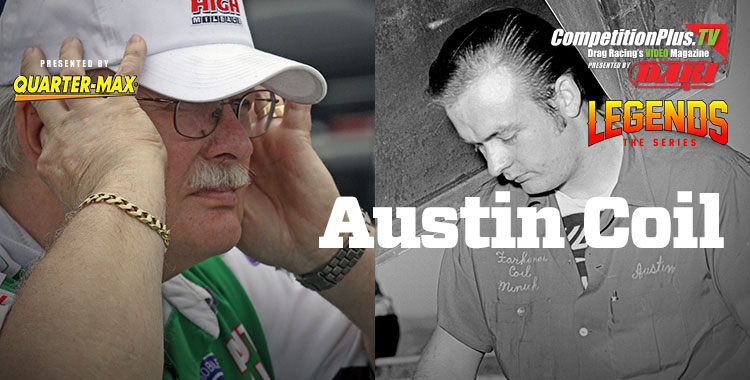
The image of Austin Coil as a cool and calculating puppet-master is debunked in this episode of Legends: The Series, Season Three in which the man who won a record 17 NHRA Championships as Funny Car crew chief to Frank Hawley and John Force owns up to what was happening beneath that seemingly calm exterior.
“I was a nervous wreck,” Coil says. “I had stomach problems. I ate Rolaids like they were candy. I was upset most of the time. I just felt like it was unprofessional to stand on the starting line and scream like a raving maniac (but) some of the old guys I worked with nicknamed me ‘The Tyrant.’ I don’t think it’s because I was so mild mannered.”
With a shout out to the late “Jungle Jim” Liberman, with whom he shared a special bond, Coil relives the era of Funny Car match racing in which the Chi-Town Hustler he campaigned with John Farkonas and Pat Minick made as many as 96 different appearances in a single season, sometimes racing five straight days at five different race tracks. Nevertheless, it wasn’t until he hooked up with Force in 1985 that Coil’s true genius was exposed.
“After two world championships we were on the verge of having to quit,” he remembered, “because our team did not have the ability to talk people out of their money. Force had the ability to get some sponsor money and not much ability to win races. It seemed like it could work (but) it was three years before we won a single race.” The rest, as they say, is history. - Dave Densmore
EPISODE 4 - THE LEGEND OF ROY HILL
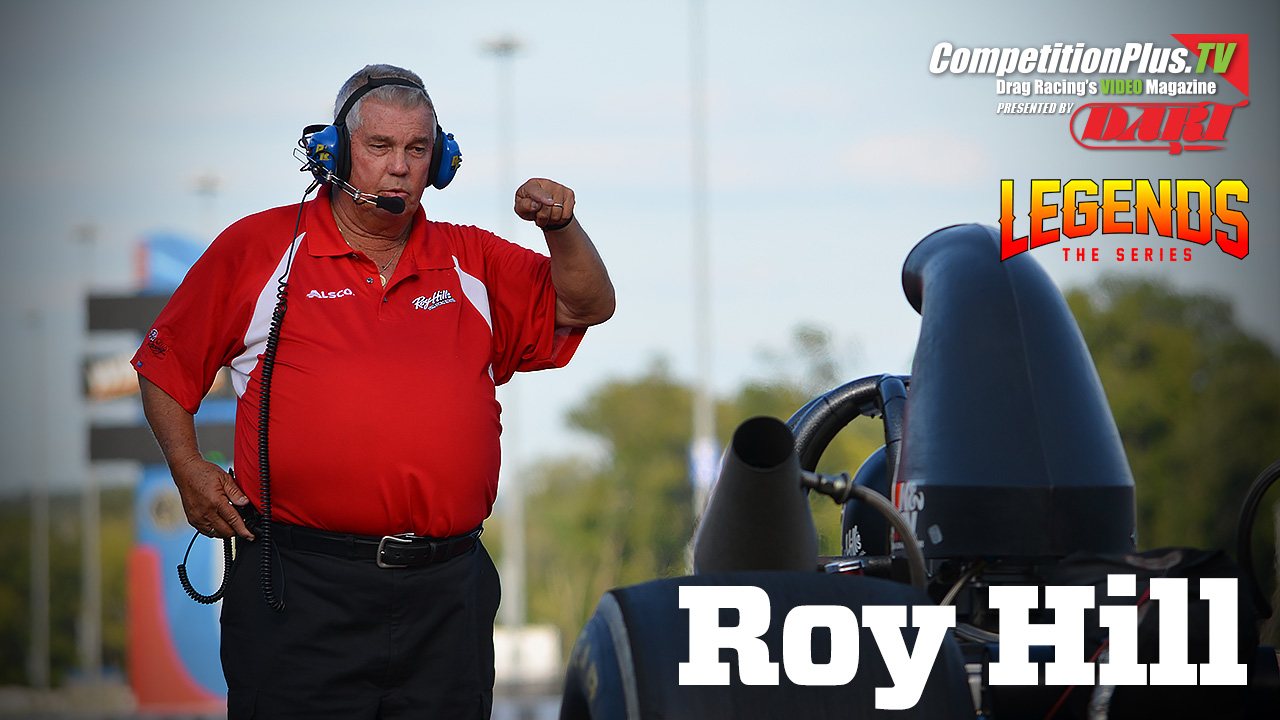 There is not a more unlikely drag racing success story than Roy Hill’s. The man they call “Hillbilly” overcame poverty, illiteracy and some admittedly questionable life choices to become not only a champion driver and car owner but also a successful businessman and entrepreneur.
There is not a more unlikely drag racing success story than Roy Hill’s. The man they call “Hillbilly” overcame poverty, illiteracy and some admittedly questionable life choices to become not only a champion driver and car owner but also a successful businessman and entrepreneur.
In this episode of Legends: The Series, Season Three, the proprietor of Roy Hill’s Drag Racing School discusses growing up on his grandparents’ North Carolina farm, leaving school in the seventh grade, his long association racing legend Richard Petty and the addicting qualities of the sport he loves.
Hill’s dad died when he was just three-and-a-half and once he was old enough to do so, he began working to supplement the $86 his mom brought home every two weeks from her job at the furniture factory.
His one diversion was drag racing.
“I’d do whatever it took to race. Sometimes it was the right thing; sometimes it wasn’t. It’s the worst addiction you can ever have (and if you) ride on that edge, sooner or later it’s going to get you.”
Although his formal education was lacking, Hill learned to be street-wise and to stay true to himself. “All I ever had was my family and my word,” he said. “I don’t tolerate anybody lying and I don’t tolerate a thief but I’ll help anybody if they ask.”- Dave Densmore
EPISODE 5 - THE LEGEND OF STEVE EARWOOD AND DAVE DENSMORE, DRAG RACING'S PUBLICISTS
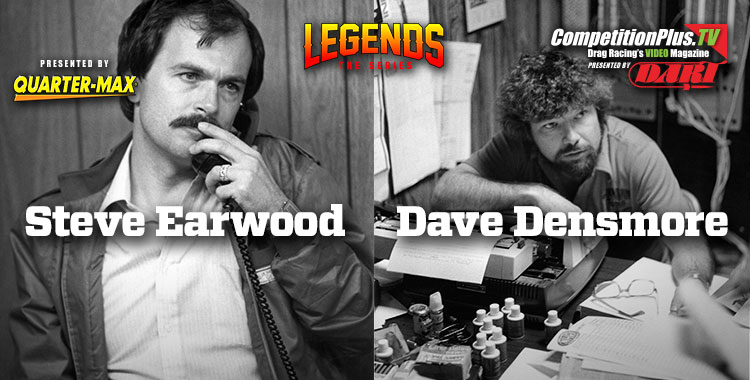 Where one was the other usually wasn't far away. And, for one of drag racing's most storied public relations tandems, this tendency hasn't changed much.
Where one was the other usually wasn't far away. And, for one of drag racing's most storied public relations tandems, this tendency hasn't changed much.
There were no manuals, nor were there any mentors when Steve Earwood and Dave Densmore took over the NHRA's Press and Publicity Department back in 1975.
Together, they painted the sport of drag racing throughout the media landscape in mainstream media, whether it was network broadcast, print or radio.
In a mix of Anchorman's Ron Burgandy and Starsky & Hutch, they were anything but conservative in their approach. Many times they colored outside of the line much to the chagrin of their NHRA bosses, but the end result was drag racing exposure, and lots of it.
In this episode of Legends: The Series, learn how they together, amidst a bad decision or five, established a solid foundation for drag racing's presentation in the media.
EPISODE 6 - THE LEGEND OF BRUCE ALLEN
 The day Bruce Allen heard that Lee Shepherd had been killed in a testing accident, he was preparing to make his Pro Stock driving debut in a car of his own at the NHRA Gatornationals at Gainesville, Fla.
The day Bruce Allen heard that Lee Shepherd had been killed in a testing accident, he was preparing to make his Pro Stock driving debut in a car of his own at the NHRA Gatornationals at Gainesville, Fla.
“You never think that things like that are going to happen to somebody that you know,” he recalled. “That just tore my heart out -- that my idol, the person I looked up to, was gone.”
Although he knew David Reher and Buddy Morrison who, with Shepherd, dominated Pro Stock racing on both the NHRA and IHRA circuits in the early 1980s, Allen was by no means a member of their inner circle.
So, in the aftermath of the Shepherd tragedy, when Reher and Morrison asked him if he would consider taking over the driving duties in their Chevrolet, he was as surprised as anyone else, particularly because of his relative lack of experience at the pro level.
“I wouldn’t have applied for the job at all because I was not worthy of doing it,” he said. “I didn’t even think in my wildest dreams that they would ever ask me to do it.”
In this episode of Legends: The Series, Season Three, Allen talks about life after Lee, about his relationship with David Reher, his near fatal crash with Kenny Koretsky at the Texas Motorplex, the real reasons that Reher-Morrison Racing and Bruce Allen no longer compete in Pro Stock, his faith and, when he’s gone, how he would like to be remembered. - Dave Densmore
EPISODE 7 - THE LEGEND OF DAVE MCCLELLAND
 In as much as actor Morgan Freeman's voice epitomizes the perceived voice of God, there's no perceiving when it comes to the voice of drag racing.
In as much as actor Morgan Freeman's voice epitomizes the perceived voice of God, there's no perceiving when it comes to the voice of drag racing.
No single voice has been more closely associated with NHRA Championship Drag Racing than that of Dave McClelland. For 42 years (1961-2003), “Big Mac” announced NHRA events, served as TV host on TNN, cut TV and radio commercials and served as emcee at countless NHRA functions from banquets to press conferences.
In this episode of Legends: The Series, Season Three, the man hailed as the forever “Voice of the NHRA” explains how he went from college in Iowa to TV cameraman in Arkansas to announcer at a dragstrip in Louisiana to General Manager of Dallas International Motor Speedway to the NHRA home office in California.
It obviously was a labor of love insomuch as his first paycheck to announce the U.S. Nationals at Indy was $25 plus a hotel room he shared with a racer from Florida. No food allowance; no travel expenses. But, as he explains, it was all part of a wonderful and unlikely journey.
EPISODE 8 - THE LEGEND OF VICTOR BRAY
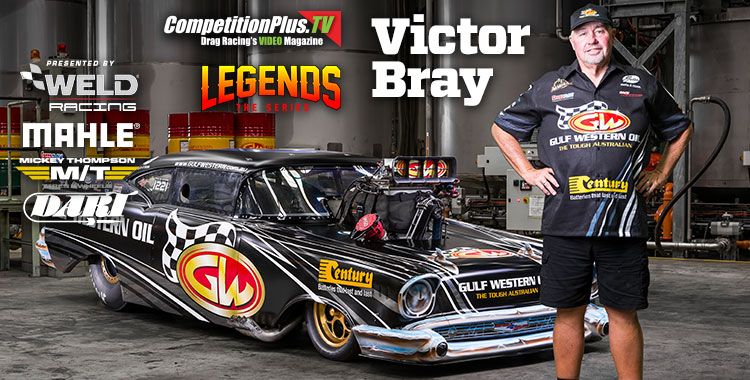 Victor Bray, it's Australian for Top Doorslammer. The first international episode for Legends: The Series travels to Brisbane, Australian, to chat with an Aussie drag racing legend.
Victor Bray, it's Australian for Top Doorslammer. The first international episode for Legends: The Series travels to Brisbane, Australian, to chat with an Aussie drag racing legend.
Bray, long considered one of the pioneers for Pro Modified style drag racing in Australia, made the unlikely journey from fifth-generation farmer to first-generation multi-time series champion.
Bray, like many of his American drag racing counterparts, used a passion for drag racing and a lust for horsepower, to propel himself into drag racing legend Down Under. In this episode, Bray discusses how this car crazy kid turned into one of his country's most successful drag racers and did it with an undying love and dedication to his family.
EPISODE 9 - THE LEGEND OF ROLAND LEONG
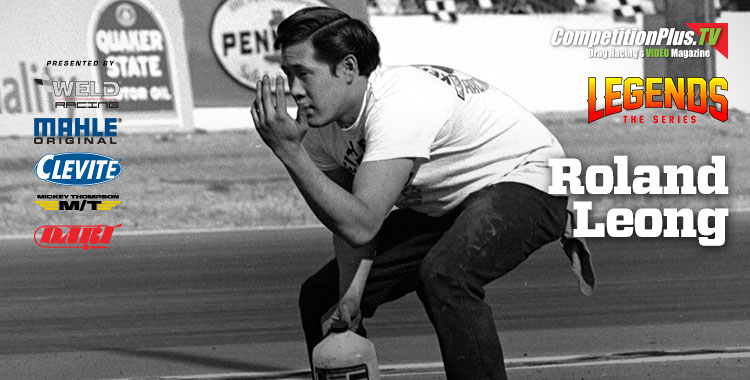 Although he had driven competitively at some loosely organized events in his native Hawaii and even though he had enjoyed some driving success in a Top Gasser on the mainland, Roland Leong probably would not have become a drag racing legend if his need for speed hadn’t sent him crashing off the end of Lions Drag Strip on his first lap as an aspiring Top Fuel driver.
Although he had driven competitively at some loosely organized events in his native Hawaii and even though he had enjoyed some driving success in a Top Gasser on the mainland, Roland Leong probably would not have become a drag racing legend if his need for speed hadn’t sent him crashing off the end of Lions Drag Strip on his first lap as an aspiring Top Fuel driver.
That accident compelled legendary track operator C.J. “Pappy” Hart to suspend his driving privileges at the sport’s most famous track, an act that steered him to an enormously successful career outside the cockpit as owner and tuner of a slew of race cars bearing the “Hawaiian” name.
In this episode of Legends: The Series, Season Three, Leong talks about growing up in Hawaii (“you either surf or you race”), about how, as 20-somethings, he and Don Prudhomme became among the first “touring pros” and about being able to do “something that people dream about doing and doing it all our lives.”
He also talks about his many drivers, about how and why he made the move from Top Fuel to Funny Car in 1969 and about how drag racing is “still something I love to do and it’s probably something I’m going to end up” doing till I die.
EPISODE 10 - THE LEGEND OF DARRELL GWYNN
 Early in 1990, 28-year-old Darrell “the Kid” Gwynn was being fitted for a crown that pundits assumed he would wear for years to come. Hailed as “the man who would be king,” he was heir apparent to Top Fuel legend “Big Daddy” Don Garlits to whom he had finished second in points in 1986. In little more than four pro seasons, he had won 18 races and finished no worse than fourth in the Top Fuel driver standings.
Early in 1990, 28-year-old Darrell “the Kid” Gwynn was being fitted for a crown that pundits assumed he would wear for years to come. Hailed as “the man who would be king,” he was heir apparent to Top Fuel legend “Big Daddy” Don Garlits to whom he had finished second in points in 1986. In little more than four pro seasons, he had won 18 races and finished no worse than fourth in the Top Fuel driver standings.
However, on Easter Sunday, shortly after winning the Gatornationals, the biggest event in his home state of Florida, fate intervened and transformed the man Garlits called “the Wolf” (“because he was so hungry”) from on-track hero to off-track inspiration. In this, the final episode of Legends: The Series, Season Three, Gwynn, now 56, talks about the sacrifices his family made to make his dream of a racing career possible, his initial naivety in thinking he could compete with Garlits and the other legends of the sport and, finally, the accident at Santa Pod Raceway in England that left him paralyzed.
The post-accident Darrell Gwynn, with the continued support of his dad Jerry, devoted himself to helping others with disabilities through the Darrell Gwynn Foundation and The Miami Project. Nevertheless, forever a racer at heart, whether racing dragster or wheelchairs, he admits that even now “I live off the memories of winning races. That’s what keeps me going.”
How about binge watching Season 2 of Legends: The Series #LEGENDStheSERIES - https://t.co/oYMJHt02mB pic.twitter.com/q1dqm1qJsN
— Competition Plus (@competitionplus) December 18, 2018
Watch the early episodes of #LEGENDStheSERIES, even the "accidental" pilot - https://t.co/tgXxlCoOFS pic.twitter.com/WyDgWyryYs
— Competition Plus (@competitionplus) December 16, 2018








